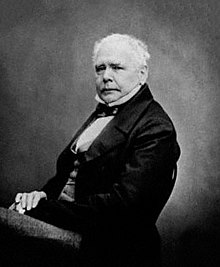William Thomas Brande
William Thomas Brande | |
|---|---|
 | |
| Born | 11 January 1788 London, England |
| Died | 11 February 1866(aged 78) Tunbridge Wells,England |
| Known for | Isolation oflithium Studies on alcohol |
| Awards | Bakerian Medal(1813, 1819) Copley Medal(1813) FRS(1809) |
| Scientific career | |
| Fields | Chemistry |

William Thomas BrandeFRSFRSE(11 January 1788 – 11 February 1866) was an Englishchemist.
Biography[edit]
Brande was born in Arlington Street,London,England, the youngest son of six children to Augustus Everard Brande an apothecary, originally from Hanover in Germany.[1]He was educated first inKensingtonand then in Westminster.[2]
After leavingWestminster School,he was apprenticed, in 1802, to his brother, anapothecary,with the view of adopting the profession of medicine.[3]
He studied medicine at Great Windmill Street Medical School and at St George's Hospital, before being drawn to chemistry following a meeting withHumphry Davy.[4]He then began to lecture in chemistry, based on a sound knowledge of which he acquired in his spare time.
In 1811 he published the first of what were to be two very influential articles on the measurement of alcohol infermented drinks,includingwine,ciderand ale.[5][6]Until that point chemists had only been able to measure alcohol in distilled drinks (brandy, gin etc.), which many early temperance reformers had assumed to be a poison. By showing that alcohol was present in fermented drinks from the start (rather than being a by-product of the distillation process), Brande undermined the long-standing view that spirits were toxic, while wine and beer were more wholesome. These findings were later propagated by the Temperance movement and used to justify total alcoholic abstinence, or teetotalism.[7]
In 1812 he was appointed professor of chemistry to theApothecaries' Society,and delivered a course of lectures before theBoard of Agriculturein place ofSir Humphry Davy,whom in the following year he succeeded in the chair of chemistry at theRoyal Institution,London.[3]In 1821 he was the first to isolate the elementlithium,which he did by electrolysis oflithium oxide.[8]
From about 1823 onwards, Brande worked increasingly with theRoyal Mint,eventually becoming Superintendent of the Coining and Die Department.[4]
Brande'sManual of Chemistry,first published in 1819, enjoyed wide popularity, and among other works he brought out aDictionary of Science, Literature and Artin 1842. He was working on a new edition when he died atTunbridge Wells.[3]
He contributed articles toRees's Cyclopædiaon Chemistry, but the topics are not known.[citation needed]
Lectures[edit]
In 1834, 1836, 1839, 1842, 1844, 1847 and 1850 Brande was invited to deliver theRoyal Institution Christmas LectureonChemistry;Chemistry of the Gases;The Chemistry of the Atmosphere and the Ocean;The Chemistry of the Non-Metallic Elements;The Chemistry of the Gases;The Elements of Organic ChemistryandThe Chemistry of Coalrespectively.
Publications[edit]
- Outlines of Geology(1817)
- Manual of Chemistry(1819)
- Manual of Pharmacy(1825)
- Dictionary of Materia Medica(1839)
- Dictionary of Science, Literature and Art(1842)
- Organic Chemistry(1854)
Family[edit]
He married Anna Frederica Hatchett, daughter of the eminent chemistCharles Hatchettin July 1818.[9]
Death[edit]
Brande died inTunbridge Wellsin 1866,[10]and is buried inWest Norwood Cemetery,London (grave 1177, square 98).
References[edit]
- ^"William Thomas Brande".gracesguide.co.uk.Retrieved16 August2016.
- ^"Archived copy"(PDF).Archived fromthe original(PDF)on 19 September 2015.Retrieved11 May2015.
{{cite web}}:CS1 maint: archived copy as title (link) - ^abcChisholm 1911.
- ^ab"William Thomas Brande (1788-1866) | The Royal Institution: Science Lives Here".rigb.org.Retrieved16 August2016.
- ^Brande, William Thomas.'Experiments to Ascertain the State in Which Spirit Exists in Fermented Liquors: With a Table Exhibiting the Relative Proportion of Pure Alcohol Contained in Several Kinds of Wine and Some Other Liquors.'Philosophical Transactions of the Royal Society of London,vol. 101, 1811, pp. 337–346. JSTOR, JSTOR, jstor.org/stable/107349.
- ^Brande, William Thomas.'Additional Remarks on the State in Which Alcohol Exists in Fermented Liquors.'Philosophical Transactions of the Royal Society of London,vol. 103, 1813, pp. 82–87. JSTOR, JSTOR, jstor.org/stable/107392.
- ^Richard Mendelson,From Demon to Darling: A Legal History of Wine in America,(University of California Press, 2009) p. 17.
- ^A Manual of Chemistry: Containing the Principal Facts of the Science, Arranged in the Order in which They are Discussed and Illustrated in the Lectures at the Royal Institution of Great Britain, William Thomas Brande and William James MacNeven, 1821, 2nd Ed., Vol. 2,p. 57.
- ^"Archived copy"(PDF).Archived fromthe original(PDF)on 19 September 2015.Retrieved11 May2015.
{{cite web}}:CS1 maint: archived copy as title (link) - ^"Archived copy"(PDF).Archived fromthe original(PDF)on 19 September 2015.Retrieved11 May2015.
{{cite web}}:CS1 maint: archived copy as title (link)
Sources[edit]
- Obituary– fromProceedings of the Royal Society of London,volume XVI, 1868, pages ii – vi (at end of volume)
- .Dictionary of National Biography.London: Smith, Elder & Co. 1885–1900.
- Material on Brande's life and deathArchived7 June 2013 at theWayback Machineby Frank James
- This article incorporates text from a publication now in thepublic domain:Chisholm, Hugh,ed. (1911). "Brande, William Thomas".Encyclopædia Britannica.Vol. 4 (11th ed.). Cambridge University Press. p. 420.
